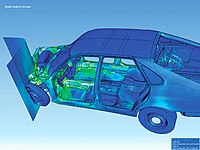
Photo from wikipedia
To meet the challenges posed by future generations of massively parallel supercomputers, a reformulation of the dynamical core for the Met Office's weather and climate model is presented. This new… Click to show full abstract
To meet the challenges posed by future generations of massively parallel supercomputers, a reformulation of the dynamical core for the Met Office's weather and climate model is presented. This new dynamical core uses explicit finite‐volume type discretizations for the transport of scalar fields coupled with an iterated‐implicit, mixed finite‐element discretization for all other terms. The target model aims to maintain the accuracy, stability and mimetic properties of the existing Met Office model independent of the chosen mesh while improving the conservation properties of the model. This paper details that proposed formulation and, as a first step towards complete testing, demonstrates its performance for a number of test cases in (the context of) a Cartesian domain. The new model is shown to produce similar results to both the existing semi‐implicit semi‐Lagrangian model used at the Met Office and other models in the literature on a range of bubble tests and orographically forced flows in two and three dimensions.
Journal Title: Quarterly Journal of the Royal Meteorological Society
Year Published: 2019
Link to full text (if available)
Share on Social Media: Sign Up to like & get
recommendations!